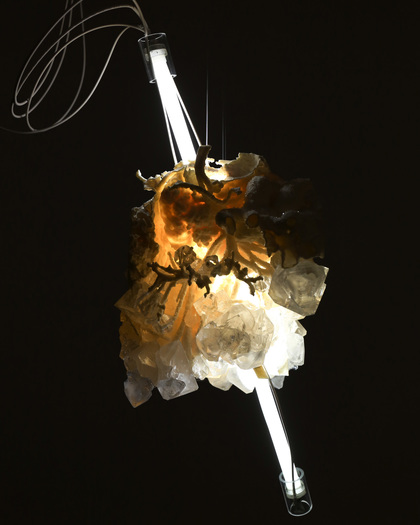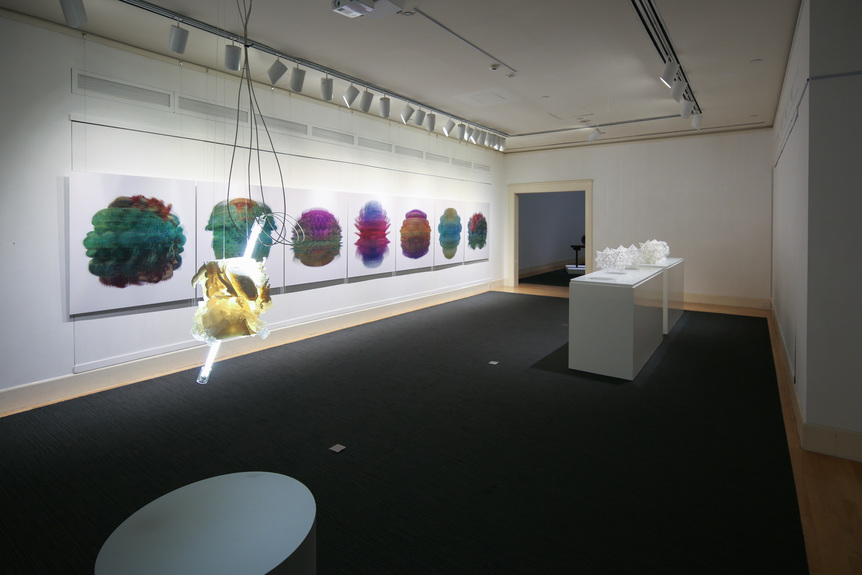-
From Current Issue
-
- Editor’s Letter Fire in the Heart
- Reviews I Gusti Ayu Kadek Murniasih
- Reviews 11th Seoul Mediacity Biennale: “One Escape at a Time”
- Dispatch Networked China
- One on One Monira Al Qadiri on Yukio Mishima
- Essays The rise of independent art spaces in pandemic-era Shanghai
- Features Tuan Andrew Nguyen
- Table of Contents
- Web Exclusives
- Archive
- Subscribe

R
E
V N
E
X
T
Detailed installation view of TOBIAS KLEIN’s Augmented Landscape, 2020, computers, VR headsets, nylon (white), 3D print (Selective Laser Sintering SLS), mini projectors, projectors, 240 × 300 × 600 cm, at “Metamorphosis or Confrontation,” University Museum and Art Gallery, The University of Hong Kong, 2020. All images courtesy the artist and University Museum and Art Gallery, The University of Hong Kong.
Digital craftsmanship seems to contradict the very notion of craftsmanship, which implies creations by hand and stresses the relationship between tools, materials, and the craftsman’s skillset. By contrast, digital evokes virtual images, software, and automated machines. Yet, developments of new tools employed by artists and designers increasingly provoke this conventional separation. Architect and artist Tobias Klein has devoted much of his career to destabilizing this dichotomy, utilizing 3D printing in addition to CAD/CAM technologies, or computer-aided design and manufacturing, in his practice.
Klein’s mid-career retrospective at The University of Hong Kong’s Museum and Art Gallery showcased works from the past decade. All designed digitally, the show’s mostly sculptural objects appear organic and eerily insectoid, calling to mind prevalent cultural depictions of extra-terrestrial beings. Titled “Metamorphosis or Confrontation,” the show explored concepts of progression and evolution in temporal and technological terms.
The main entrance of the exhibition was filled with objects, laid out across a large central table and in surrounding glass cabinets. The space conjured both a studio and a Victorian-era natural history museum, referred to by Klein as his Wunderkammer (cabinet of curiosities). Rows of design sketches and photographs of the artist’s inspiration—buildings, aquatic organisms, historical artefacts—lined the back of these cabinets, outlining his process and multidisciplinary research. One of the sculptures on the table, Vessels of Vanitas II (2016), draws upon the elaborate stylistic forms of Rococo, itself modelled after nature, with its curved forms and organic motifs. The 3D printed resin model is highly intricate, with symmetric nodes and undulating stems seemingly growing from the main body. The extravagant design of this “vessel,” the shape of which is inspired by funerary urns, reflects the futility of acquiring ephemeral earthly gains, as expressed by vanitas art. The delicate skeletal and arterial details further emphasize life’s fragility.
The dimly lit room that followed held a pair of screens mounted on each side of a free-standing wall, projecting a choreographed virtual reality (VR) experience, Augmented Landscape (2020). On one side, seated participants tread through a barren dystopian terrain facing the sea; on the opposing screen was a nocturnal view of the same landscape but facing the mountains. In both scenarios, viewers encounter and interact with a floating, peculiarly formed mask-like entity. The photorealistic VR surroundings ultimately collapse into black-and-white renderings, exposing the settings as digital illusions, while large mirrors that appear at the end reveal to participants that they themselves are the masked creatures. The masks borrow design elements from headpieces of Cantonese opera, and through embarking on the VR journey, participants unknowingly become actors of the performance, insinuating a world where illusions permeate realities.
The idea of change was particularly pronounced in the third room. The Invisible Human—Abdomen (2013)—a lit incubator lined with dense crystal formations—was exhibited as an interactive installation in 2013 at Industry Gallery in Washington, DC, where attached infra-red sensors detecting the proximity of viewers generated heat to induce crystallization. The crystals grown from that month-long display envelope a 3D printed, digitally sectioned MRI scan of a human abdomen on the incubator, influencing the final shape of the work. In this way, the artificial crystals cultivated from the earlier public interactions instil life into the inanimate object, contrary to the natural and often harmful crystallization that occurs in the human body, such as the formation of kidney stones. Nearby, Melted Proportions I–VI (2019) comprises six 3D printed resin sculptures—each appearing more eroded than the last—that portray a gradual mutation of Leonardo da Vinci’s polyhedron into a spherical, tangled form.
The conflating of old and new craftsmanship was all the more evident in the final room, where antique Qing-dynasty wooden and lacquered tables served as stands for the artist’s ornamental glass objects, fused with digitally printed tendril-like structures. Resembling primordial mitosis, the blown-glass vessels, a form of analogue craft, were cut into two before being 3D scanned and fitted with the polymer constructs. In this space, Klein articulates the amalgamation of materials as well as the combination of traditional and digital techniques, challenging dichotomic readings of the two.
Lauren Long is ArtAsiaPacific’s news and web editor.
Tobias Klein’s “Metamorphosis or Confrontation” is on view at The University Museum and Art Gallery, The University of Hong Kong, until October 4, 2020. Please check the exhibition web page for up-to-date information in light of Covid-19.
To read more of ArtAsiaPacific’s articles, visit our Digital Library.

















